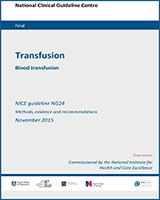| Relative values of different outcomes | The GDG considered all-cause mortality at 30 days, infections (including pneumonia, surgical site infection, UTI and septicaemia/bacteraemia), quality of life, acute and delayed serious adverse events and new cardiac events as the critical outcomes for decision making. Other important outcomes included the number of patients transfused, the number of units transfused and length of stay in hospital. |
| Trade off between clinical benefits and harms | The evidence from the combined review comparing restrictive and liberal targets in adults suggested that there was clinically important benefit with the use of restrictive targets for the outcomes number of patients transfused and number of units transfused. The evidence suggested that there may be clinical benefit with respect to mortality (all -cause at 30 days), new cardiac events, length of hospital stay and adverse events in patients being transfuse to restrictive target levels, however there was some uncertainty within the effect estimates to allow confident interpretation of clinical benefit or harm for these outcomes. No difference was observed between the groups with respect to incidence of infections (pneumonia).
No evidence was identified for outcome quality of life. There was evidence from one study comparing restrictive and liberal targets in children. The evidence showed clinically important benefit for restrictive strategy for the outcome number of patients transfused. The evidence suggested that there may be a benefit with the use of restrictive targets with respect to infections; however there was considerable uncertainty within the effect estimate. The evidence suggested that there may be no difference between groups with respect to the total volume of RBC transfused, mortality, ICU length of stay and pulmonary oedema, but there was considerable uncertainty within the effect estimates to allow confident interpretation of clinical benefit or harm for these outcomes.
No evidence was identified for the critical outcome quality of life in children.
The GDG discussed the specific thresholds and target levels for RBC transfusion and based the recommendation on the threshold and target ranges used in the studies. Many of the studies that used the most restrictive thresholds (Hb 70g/L) have been conducted in the sickest patient groups, for example critically ill patients in the ICU. Most other studies used a restrictive haemoglobin threshold of 80 g/L. The GDG considered that the safety of Hb triggers of 70g/L in these situations, especially for younger adult patients and those without cardiovascular co-morbidity, supported this threshold for most patients. |
| Economic considerations | No economic evidence was identified to independently evaluate the effect of different thresholds or targets of haemoglobin concentration for blood transfusion. The specific threshold and targets outlined for a restrictive strategy are based on those reported in majority of the evidence identified in the clinical review. Economic considerations for a restrictive strategy are described in the LETR above. |
| Quality of evidence | The quality of evidence for all outcomes was low or very low by GRADE criteria for both the combined RBC thresholds and RBC targets review This was largely because of risk of bias arising from a lack of allocation concealment, inadequate blinding and serious or very serious imprecision.
There was also considerable variation within the studies in the levels of haemoglobin concentration used for haemoglobin targets. The economic evaluation was assessed as partially applicable with potentially serious limitations. The GDG agreed that the same recommendations should apply for children as for adults. |
| Other considerations | The recommendation applies to adults and children requiring RBC transfusions.
The GDG discussed that it was important to assess the patient's signs and symptoms for example the presence of chest pain, breathlessness, ECG changes, or other signs of myocardial ischaemia prior to setting transfusion thresholds. It was noted that there were two on-going trials comparing restrictive and liberal threshold strategies, the TRIGGER trial (transfusion in gastrointestinal bleeding and the TRIST trial (transfusion of red cell in haematopoietic stem cell transplantation). The TRIGGER trial, an open label trial in patients with acute gastro-intestinal bleeding, was published following consultation of this guideline. The study was not included in the clinical review but the study results do not conflict with the recommendation.144
The GDG noted that this recommendation, in the context of a cross cutting guideline focussing on the general principles of transfusion and the appropriate use of blood does not exclude any specific clinical condition, including oncology patients. However the detailed management of specific clinical conditions was not considered and the physician should follow appropriate guidance specific to clinical conditions, as appropriate. |
